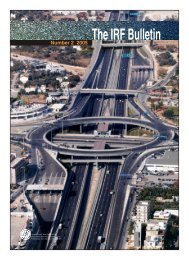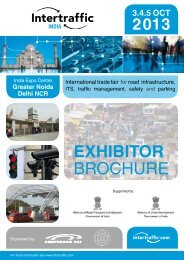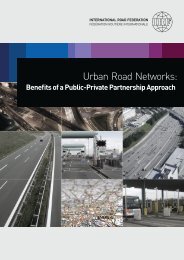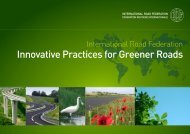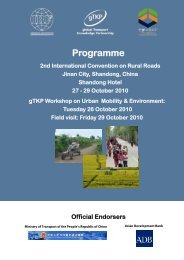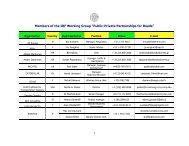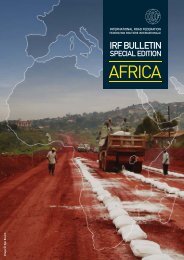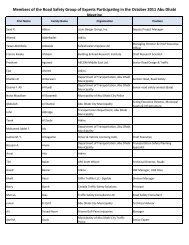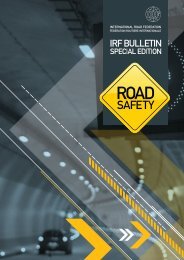TRANSPORT
TRANSPORT
TRANSPORT
- No tags were found...
Create successful ePaper yourself
Turn your PDF publications into a flip-book with our unique Google optimized e-Paper software.
MANAGEMENT<br />
Fourthly, appropriate road standards should be applied. Rural<br />
roads must fit into the economic and social environment of<br />
the individual country. No internationally agreed standards<br />
for rural roads currently exist – even the very term, ‘rural<br />
road’, lacks a clear definition. Thus, a rural road in Central<br />
Europe (e.g. according to German standardisation) may<br />
carry an axle load of 10 tonnes, allowing heavy agricultural<br />
harvesting plants access to the fields, while in the least<br />
developed countries the term might commonly refer to<br />
an earth path, running over natural ground, equipped<br />
with a culvert at a water crossing. The level of economic<br />
development not only influences motorisation, production<br />
and transport volumes but also limits the state budget and<br />
the size of the country’s sustainable road network.<br />
A detailed cost/benefit analysis – as applied to national roads<br />
– is not, however, generally suited or recommended for<br />
rural roads. Therefore, a general orientation (as established<br />
by the German Agency for Technical Cooperation, GTZ,<br />
using data from 15 different developing countries) may be<br />
useful. As may been seen from figure 3, the GTZ model<br />
uses the World Bank’s standard classification (2005),<br />
which divides the countries of the world into 5 economic<br />
categories: Least Developed Countries (LDC), which refers<br />
to countries having a GDP of up to US$ 350 per capita<br />
(p.c.), e.g. Ethiopia; Low Income Countries (LIC), with a<br />
GDP of up to US$ 745 p.c., e.g. Ghana; Lower Middle<br />
Income Countries (LMIC) with a GDP of up to US$ 2,975<br />
p.c., e.g. The Philippines; Upper Middle Income Countries<br />
(UMIC), GDP of up to US$ 9,260 p.c., e.g. Romania; and<br />
High Income Countries (HIC), GDP of up to US$ 40,000<br />
p.c. or more, e.g. Korea.<br />
With respect to each economic class, approximately five<br />
technical road standards are shown with crosses on the<br />
table, with the lowest in each case indicating the relevant<br />
definition of ‘rural road’. Thus, the technical RR standard<br />
for an LIC category country (e.g. Ghana) would, according<br />
to the GTZ general orientation, be an ‘earth road’ with<br />
‘pick-up’ services, having an average vehicle density of up<br />
to 35 vehicles per day.<br />
The left-hand column of the table shows ten classes of<br />
roads for motorised transport, starting with a ‘way’ –<br />
which corresponds to a vehicle density of 6 vehicles per<br />
day (Average Annual Daily Traffic) – and moving up to a<br />
‘turnpike’ carrying over 30,000 vehicles per day. Another<br />
column gives the relative road construction costs of each<br />
category, rising from a drained ‘earth road’ which may<br />
only require approximately 5% of the construction cost of<br />
a standard road (which in the table is represented by an EU<br />
community road with an 8 cm bitumen mix).<br />
IRF BULLETIN SPECIAL EDITION: RURAL <strong>TRANSPORT</strong>, VOLUME-2 | 27



